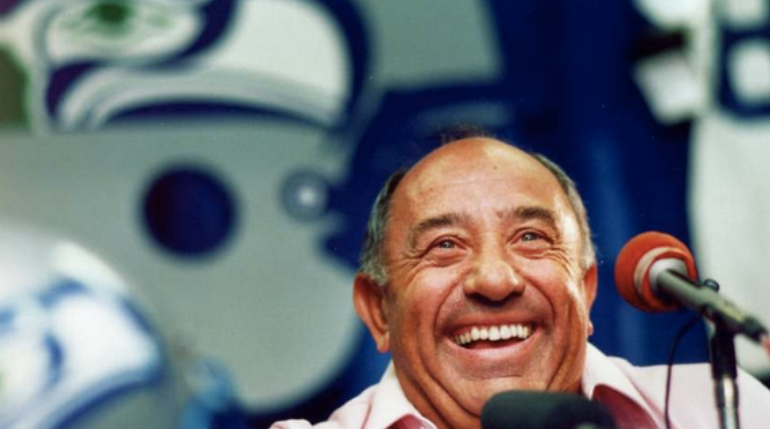Years later, Colin Behring still remembers the evening of his senior year homecoming game. It was 2001 and Monte Vista’s administrators had made a big mistake. They’d scheduled both the homecoming dance and the homecoming football game at the same time.
Eventually, the news reached Colin Behring’s grandfather, Ken Behring. He didn’t demand that the school change the date or disregard his grandson, instead, he did what he usually did: he found a different path entirely.
After MV won the game against Livermore by a landslide, the entire school was invited to celebrate in the ballroom of Behring’s home. Surrounded by black granite and priceless cars, the evening was any high schooler’s fantasy. This August, that same house hit the market.
Listed at $25 million, the estate is a culmination of Ken Behring’s life’s work as an entrepreneur, philanthropist, football fanatic, car collector, and colloquially, the founder of Blackhawk.
But Behring’s journey started far away from the well-trimmed golf courses and sprawling mansions of Blackhawk.
He grew up in the small town of Monroe Wisconsin, taking up odd jobs delivering the newspaper and working in a cheese factory.
At 17, Behring was selling automobiles at a Chevrolet and Chrysler dealership. He quickly realized that he hated working for someone else, so he became his own boss. At 24 he’d saved enough to buy his own used car dealership. This was the first of many risky business moves Behring would make. With no inheritance or safety net to fall back on, the only collateral he had was himself.
Behring’s first big move was from Wisconsin to Florida where he started the Behring Construction Company in Fort Lauderdale. Where most saw wetlands and pastures, Behring saw an opportunity. He founded Tamarac Lakes, an active adult community in 1962. His company eventually became the largest builder of single-family homes in Florida.
Behring came to California in 1977 with his eyes set on the rolling hills and flowering valleys of Mount Diablo. After battles with environmentalists, he won the right to develop 5,000 acres of land at the foot of Mt. Diablo. Here, he not only established the Blackhawk Country Club, but cemented Blackhawk as his private reserve.
By 1988, Behring felt as if he’d lost touch with his roots. So he looked back to his humble upbringing during the Great Depression. When he wasn’t selling Hudsons, covering paper routes, mowing lawns, working in cheese factories, or caddying, he dreamt of cars and played football.
In Monroe, your car was your status symbol. His vehicle of choice? A sleek Rolls-Royce.
But it’s the 250 cars he quietly spent seven years purchasing from collections, auctions, and backcountry barns worldwide culminating in the Blackhawk Museum that is the ultimate symbol of the ascent of the son of a lumber yard worker from Wisconsin.
Some say Behring’s collection is the nicest of its kind—a collection worth about $100 million. He displayed a 1935 Duesenberg owned by Clark Gable, a ‘31 Bentley once owned by William Vanderbilt Jr., and a ‘26 Isotta Fraschini owned by Rudolph Valentino. Tucked in the shadow against a side wall, Adolf Hitler’s 1939 Mercedes-Benz armored tourer was also on display at the grand opening in 1988.
Behring’s search for iconic cars extended past traditional venues. He windowshopped the world. He accepted classic cars as down payments on homes in his Blackhawk developments. He once bought a 179-car collection just to get six—including a Mercedes roadster supposedly once owned by Joseph Stalin. Some found his penchant for cars owned by the infamous strange, but Behring liked cars with a story. For him, history gave them a personality. One of his favorites? A Duesenberg was once owned by Clarke Gable and Carol Lombard. It wasn’t the flashiest or most expensive car, but Behring loved the story it told. He could practically envision them sitting in the leather seats, driving from Hollywood to Oregon and back.
It’s this idea, Behring’s appreciation of the story, and his desire to see the sleek metal as an art form that keeps his collection from being just another millionaire’s dusty indulgence.
In the same year, the former high school fullback settled for the next best thing to throwing professional footballs. He bought his team, the Seattle Seahawks for $80 million. His time in the NFL was short-lived and marked by controversy. Microsoft co-founder Paul Allen bought the team from Behring for $200 million in 1997.
“Once again I was starting over — without football, but with the money and time to look for real purpose in my life,” Behring recounts in his 2004 memoir, “The Road to Purpose.”
For Behring, this meant giving much of his fortune away.
He donated $20 million to the Smithsonian Institution in Washington, D.C. 2000. At the time, it was the single largest donation to a U.S. museum. He also gave $7.5 million to the Principal Leadership Institute at Berkeley. His gift to higher education was somewhat ironic as he only completed one semester at the University of Wisconsin.
Perhaps his most substantial contribution was starting Wheelchairs for the World, a non-profit that provides wheelchairs to those who cannot afford them. Since he founded the organization in 2000, over one million wheelchairs have been provided to people in need throughout the world.
The organization has not only had a lasting legacy on those who benefit from it but also the MV community. Just last month, Monte Vista hosted a discussion panel with one of the wheelchair recipients from Behring’s foundation.
Since Ken’s passing in 2019, Behring’s Blackhawk home has served as a reminder of his work ethic and passion for life. The pending sale is bittersweet but doesn’t detract from his legacy.
“One of the biggest pieces of advice I remember growing up from Grandpa Ken would probably have been the idea of perseverance,” Colin said. “
Everything will go wrong all at the same time and you need to be able to weather it and get through it. You’re going to feel like it’s the darkest of days, but you need to know that it is going to happen sooner or later and you need to just get through it. It will pass.”














